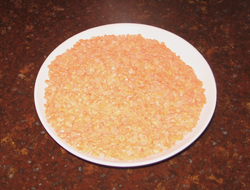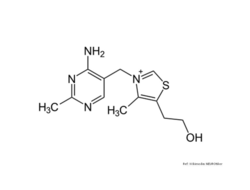Vitamin B1: Thiamin
Published: July 15, 2022
As with most water soluble vitamins, thiamin cannot be stored in your body for long periods of time and must be replenished daily.
Although thiamin is only required in small amounts, the vitamin has several important functions in your body.
Functions of thiamin
Thiamin forms part of thiamine diphosphate (TDP) a coenzyme which is required in energy metabolism in all cells of your body especially your nerve and muscle cells.
TDP is specifically involved in the process of converting pyruvate to acetyl Co A, an important step in energy metabolism.
Pyruvate is a product of glycolysis; the process by which small amounts of ATP (adenosine triphosphate) are released from glucose.
The conversion of pyruvate to acetyl Co A is necessary for the synthesis of more ATP.
TDP is also necessary for the conversion of alpha-ketoglutarate, and three amino acids, isoluceine, leucine, and valine, during synthesis of ATP.
Acetyl CoA is also required for the synthesis of fatty acids, cholesterol and other important compounds in your body.
In addition, TDP acts as a co-enzyme in the synthesis of pentoses (5 carbon sugars) required for the synthesis of metabolically important compounds such as:
- aldopentose ribose a component of ATP
- ADP (adenosine diphoshpate)
- AMP (adenosine monophosphate).
Ribose (a pentose) in various forms is a component of your DNA (deoxyribonucleic acid) and RNA (ribonucleic acid).
As ribotol, ribose is a component of vitamin B2 (riboflavin) and of flavin coenzymes FAD (flavin adenine dinucleotide) and FMN (flavin mononucleotide) which are both involved in energy metabolism.
TDP is also required for the synthesis of NADPH (nicotinamide adenine dinuleotide phosphate) another compound active in energy metabolism.
Membrane and nerve conduction are also dependent on thiamin.
Daily requirement
The RDA (recommended daily allowance) for thiamin is primarily based on thiamin's enzymatic role.
The RDA is the average daily amount of thiamin which is considered adequate to meet the requirements of most healthy people.
- 0-5 months = 0.2 mg/day
- 6 months – 1 year = 0.3 mg/day
- 1-3 years = 0.5 mg/day
- 4-8 years = 0.6 mg/day
- 9-13 years = 0.9 mg/day
- Males > 14 years = 1.2 mg/day
- Females > 14 = 1.1 mg/day
- Pregnancy and lactation = 1.4 mg/day
Deficiency
It is thought most people in North America, including Canada...link to the full article to learn more.
References
1.
Gropper, S.S., Smith, J.L. & Groff, J.L. (2005). Advanced Nutrition and Human Metabolism (4thEd.). Belmont, CA: Thomson Wadsworth.
2.
Whitney, E. & Rady Rolfes, S. (2005). Understanding Nutrition. Belmont, CA: Thomson Wadsworth


